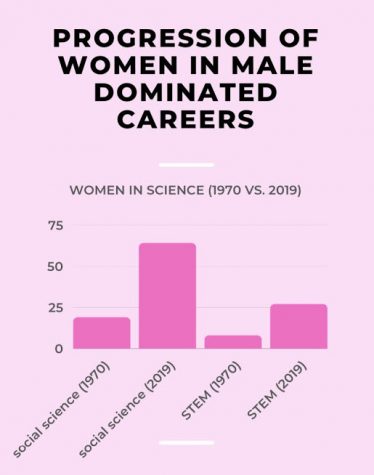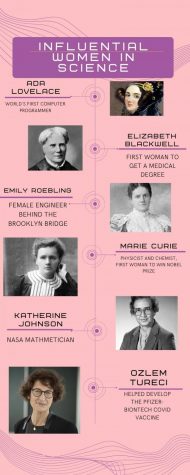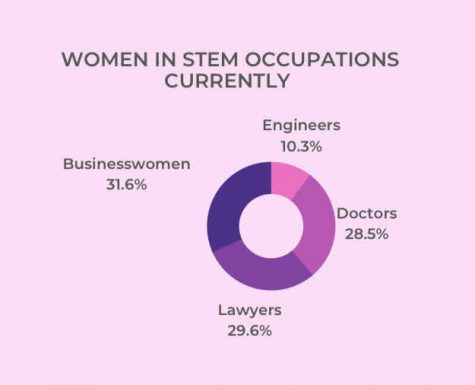Women in Science: Breaking Gender Barriers
March 26, 2021
For much of history, the fields of science, technology, engineering, and mathematics (commonly known as STEM), as well as medicine have been mainly dominated by men. For centuries, many people believed that there was no place for a woman in science, but today, much of these prejudices have faded and the worlds of STEM and medicine have changed for the better. This progress would not have been possible without the efforts and achievements of many trailblazing female scientists, doctors, mathematicians, engineers, chemists, physicists, and more. These courageous women shattered the glass ceiling: they fought, sometimes they failed, but nevertheless, they persisted.
Some of the most notable early women in science are Ada Lovelace, the world’s first computer programmer, Elizabeth Blackwell, the first woman to earn a medical degree in the United States, and Emily Roebling, the female engineer behind the Brooklyn Bridge, one of the greatest, most difficult engineering projects in history. Each was a woman of firsts, and broke down walls that had long barred women from joining the fields of STEM and medicine, which at the time (the 19th century), were seen as “a man’s world”. Yet even so, the fight for gender equality for women in science was still far from over.

As Marie Curie, one of history’s most influential scientists, once said, “I was taught that the way of progress was neither swift nor easy.” Curie’s own experiences as a female physicist and chemist are a testament to this, because throughout her life, she faced many barriers because of her gender. Curie was unable to attend universities in Warsaw, was refused from jobs as a scientist in Poland, and was even almost excluded from being recognized with a Nobel prize, all because she was a woman. Nevertheless, she persevered, and not only did Curie become the first woman to win a Nobel prize, but she is also the first person (man or woman) to win two Nobel prizes, and the only person to win Nobel prizes in two different categories (physics and chemistry). Curie’s work revolutionized the world’s understanding of radioactivity and paved the way for huge advancements in medicine, in physics, in nuclear science, and more.

Although Curie’s work was eventually recognized in her lifetime, and rightfully so, most female scientists of her time weren’t given the same acknowledgment. For a long time, women fought to earn a place in science, often struggling just to get a seat in a laboratory, only to be overlooked for their contributions. Even today, there still are countless under-celebrated women in science who have not yet received the recognition and appreciation that they deserve. A remarkable “hidden figure” in STEM was mathematician Katherine Johnson, whose mathematical calculations and research played a critical role in many of NASA’s projects, including John Glenn’s famous orbital mission. In fact, Johnson was so well respected at NASA that Glenn himself actually asked if Johnson could manually double check his mission’s flight calculations, which had originally been done on computers. However, despite her success and talent, as an African American woman in the mid-twentieth century, Johnson regularly faced racial and gender discrimination. She and her fellow African American colleagues had to use segregated bathrooms and lunchrooms, and for a long time, Johnson was not allowed to put her name on any papers she wrote or helped write, which meant she often did not get credit for her research. Johnson’s work was finally celebrated in the hit 2016 film, Hidden Figures, a biographical film centered around the incredible stories of Johnson, NASA mathematician Dorothy Vaughan, and NASA aerospace engineer Mary Jackson.
Today, inspirational female scientists continue to play pivotal roles in STEM and medicine. As the Covid-19 pandemic raged on, one prominent female scientist at the forefront of Covid-19 vaccine research was Ozlem Tureci, the chief medical officer and cofounder of BioNTech. Dr. Tureci played a big part in developing the Pfizer-BioNTech Covid-19 vaccine, the first authorized Covid-19 vaccine in the United States and a crucial turning point in the Covid-19 pandemic. Additionally, the world has come a long way in terms of recognizing and celebrating women in science and their work. The 2020 Nobel Prizes honored not one, but three women for their groundbreaking scientific contributions. Last October, Andrea Ghez won the Nobel prize in physics, the fourth woman ever to do so, and Emmanuelle Charpentier and Jennifer A. Doudna were awarded the Nobel prize in chemistry, marking the first time two women have shared this award.

Without a doubt, the landscape of the STEM and medicine fields has progressed significantly through the years. Just thirty years ago, in 1970, women made up only 8% of the workforce in science-related fields, according to the United States Census Bureau. 49 years and a multitude scientific advancements later, in 2019, the percentage of women in the STEM workforce had grown to 27%. In 2019, women made up nearly half of all occupations in math (47%) and in life and physical sciences (45%). The representation of women in social science occupations has also significantly increased, rising from 19% in 1970 to 64% in 2019. Furthermore, according to the United Nations, today, women make up 70% of healthcare workers, globally.
These increases, without a doubt, represent significant milestones for women in medicine and STEM, but there is still work to be done. Although women do make up the majority of social science workers, social science only accounts for 3% of STEM occupations. Computer science and engineering make up 80% of the STEM workforce, but in 2019, women only made up about 25% of computer workers and 15% of engineers. The percentage of women in engineering has increased since 1970, from 3% to 15%, but the percentage of women in computer science (although an overall increase from 1970), has actually decreased from 1990 to 2019. Women are still an underrepresented minority in these fields, and stereotypes, wage disparity, and bias against women still exist. However, we have the power to continue to break down gender barriers in science. In fact, if you simply look around Cherry Hill East, you can find so many young girls who hope to pursue a career in STEM or medicine, as doctors, engineers, computer scientists, biologists, mathematicians, and more.
It was much in part to these pioneering women in science that East students, as well as girls around the world, can even begin to dream of a career in science. These pioneers, and multitudes of other influential women in science such as Rosalind Franklin, Chien-Shiung Wu, Jane Goodall, Sally Ride, Rachel Carson, Amelia Earhart, and Gladys West, as well as countless impactful hidden figures who continue to be left out of history books, have not only contributed invaluable advancements to the fields of STEM and medicine, but also continue to inspire generations of young people.
Katherine Johnson once said, “We will always have STEM with us. Some things will drop out of the public eye and will go away, but there will always be science, engineering, and technology. And there will always, always be mathematics.” And as long as we have STEM and medicine, the world will need persevering women to play a part in them.